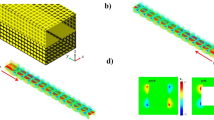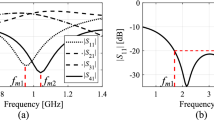Abstract
Microwave isolators, developed after World War II, are essential non-reciprocal devices widely used to minimize signal reflections and interference across various applications, including mobile base stations, satellite communications, radar systems, magnetic resonance imaging and industrial microwave heating. A typical commercial microwave isolator provides 20 dB of isolation, reducing the backward power by two orders of magnitude. Although higher isolation is always desired for systems that require greater power or lower noise, such as superconducting quantum computing, further reduction in the backward signal will inevitably lead to an unacceptable degradation in the forward transmission in traditional designs. Here we introduce the principle of a topological isolator, based on a unique one-way edge waveguide that spatially separates forward and backward waves, allowing for the complete absorption of the backward-propagating mode without compromising any forward signal. This ideal isolation mechanism produces an unprecedented isolation level, analytically derived to be 200 dB within a single-wavelength-size device. It is limited only by the evanescent fields within the topological bandgap in the ferrite material that spans two octaves around 10 GHz. We experimentally demonstrate this topological isolator in a stripline configuration with a minimal insertion loss of 1 dB and a backward signal deeply attenuated to the instrument noise floor. This results in an ultrahigh isolation exceeding 100 dB—an eight-orders-of-magnitude improvement over conventional counterparts. Our work not only paves the way for higher-performance isolators in the aforementioned technologies but also sets the stage for innovation in a variety of related microwave components.
This is a preview of subscription content, access via your institution
Access options
Access Nature and 54 other Nature Portfolio journals
Get Nature+, our best-value online-access subscription
$32.99 / 30 days
cancel any time
Subscribe to this journal
Receive 12 print issues and online access
$259.00 per year
only $21.58 per issue
Buy this article
- Purchase on SpringerLink
- Instant access to full article PDF
Prices may be subject to local taxes which are calculated during checkout




Similar content being viewed by others
Data availability
The data presented in the main text are available via Figshare at https://doi.org/10.6084/m9.figshare.29554457 (ref. 44). All other data that support the findings of this work are available from the corresponding author on reasonable request.
References
Button, K. Microwave ferrite devices: the first ten years. IEEE Trans. Microw. Theory Techn. 32, 1088–1096 (1984).
Pozar, D. M. Microwave Engineering 4th edn (John Wiley & Sons, 2012).
Linkhart, D. K. Microwave Circulator Design 2nd edn (Artech House, 2014).
Bosma, H. On stripline Y-circulation at UHF. IEEE Trans. Microw. Theory Techn. 12, 61–72 (1964).
Fay, C. & Comstock, R. Operation of the ferrite junction circulator. IEEE Trans. Microw. Theory Techn. 13, 15–27 (1965).
Krinner, S. et al. Engineering cryogenic setups for 100-qubit scale superconducting circuit systems. EPJ Quantum Technol 6, 2 (2019).
Enander, B. A new ferrite isolator. Proc. IRE 44, 1421–1430 (1956).
Weisbaum, S. & Seidel, H. The field displacement isolator. Bell Syst. Tech. J. 35, 877–898 (1956).
Schlomann, E. On the theory of the ferrite resonance isolator. IRE Trans. Microw. Theory Techn. 8, 199–206 (1960).
Hines, M. Reciprocal and nonreciprocal modes of propagation in ferrite stripline and microstrip devices. IEEE Trans. Microw. Theory Techn. 19, 442–451 (1971).
Jalas, D. et al. What is—and what is not—an optical isolator. Nat. Photon. 7, 579–582 (2013).
Estep, N. A., Sounas, D. L., Soric, J. & Alù, A. Magnetic-free non-reciprocity and isolation based on parametrically modulated coupled-resonator loops. Nat. Phys. 10, 923–927 (2014).
Shi, Y., Yu, Z. & Fan, S. Limitations of nonlinear optical isolators due to dynamic reciprocity. Nat. Photon. 9, 388–392 (2015).
Sounas, D. L., Soric, J. & Alù, A. Broadband passive isolators based on coupled nonlinear resonances. Nat. Electron. 1, 113–119 (2018).
Kord, A., Sounas, D. L. & Alu, A. Microwave nonreciprocity. Proc. IEEE 108, 1728–1758 (2020).
Nagulu, A. & Krishnaswamy, H. Non-magnetic non-reciprocal microwave components—state of the art and future directions. IEEE J. Microw. 1, 447–456 (2021).
Zhang, Z., Delplace, P. & Fleury, R. Superior robustness of anomalous non-reciprocal topological edge states. Nature 598, 293–297 (2021).
Fernandes, D. E., Pereira, R. A., Lannebère, S., Morgado, T. A. & Silveirinha, M. G. Experimental verification of ill-defined topologies and energy sinks in electromagnetic continua. Adv. Photon. 4, 035003 (2022).
Masui, S., Kojima, T., Uzawa, Y. & Onishi, T. A novel microwave nonreciprocal isolator based on frequency mixers. IEEE Microw. Wireless Technol. Lett. 33, 1051 (2023).
Jiang, T. et al. Wideband isolator based on one-way surface magnetoplasmons with ultra-high isolation. Sci. Rep. 14, 17474 (2024).
Jia, R. et al. On-chip active non-reciprocal topological photonics. Adv. Mater. 37, 2501711 (2025).
Lu, L., Joannopoulos, J. D. & Soljačić, M. Topological photonics. Nat. Photon. 8, 821–829 (2014).
Ozawa, T. et al. Topological photonics. Rev. Mod. Phys. 91, 015006 (2019).
Haldane, F. D. M. & Raghu, S. Possible realization of directional optical waveguides in photonic crystals with broken time-reversal symmetry. Phys. Rev. Lett. 100, 013904 (2008).
Wang, Z., Chong, Y., Joannopoulos, J. D. & Soljačić, M. Observation of unidirectional backscattering-immune topological electromagnetic states. Nature 461, 772–775 (2009).
Fuller, A. J. B. Ferrites at Microwave Frequencies (IET, 1987).
Harris, V. G. Modern microwave ferrites. IEEE Trans. Magn. 48, 1075–1104 (2012).
Hartstein, A., Burstein, E., Maradudin, A. A., Brewer, R. & Wallis, R. F. Surface polaritons on semi-infinite gyromagnetic media. J. Phys. C: Solid State Phys. 6, 1266 (1973).
Silveirinha, M. G. Chern invariants for continuous media. Phys. Rev. B 92, 125153 (2015).
Okamoto, A., Shindou, R. & Murakami, S. Berry curvature for coupled waves of magnons and electromagnetic waves. Phys. Rev. B 102, 064419 (2020).
Zhang, X., Li, W. & Jiang, X. Confined one-way mode at magnetic domain wall for broadband high-efficiency one-way waveguide, splitter and bender. Appl. Phys. Lett. 100, 041108 (2012).
Seewald, C. K. & Bray, J. R. Ferrite-filled antisymmetrically biased rectangular waveguide isolator using magnetostatic surface wave modes. IEEE Trans. Microw. Theory Techn. 58, 1493–1501 (2010).
Helszajn, J. The Stripline Circulator: Theory and Practice (John Wiley & Sons, 2008).
Courtois, L., Bernard, N., Chiron, B. & Forterre, G. A new edge-mode isolator in the very high frequency range. IEEE Trans. Microw. Theory Techn. 24, 129–135 (1976).
Talisa, S. & Bolle, D. On the modeling of the edge-guided mode stripline isolators. IEEE Trans. Microw. Theory Techn. 27, 584–591 (1979).
Fesharaki, F., Akyel, C. & Wu, K. Broadband substrate integrated waveguide edge-guided mode isolator. Electron. Lett. 49, 269–271 (2013).
Zeng, L., Tong, C.-Y. E. & Paine, S. N. A low-insertion loss cryogenic edge-mode isolator with 18 GHz bandwidth. IEEE J. Microw. 3, 1258–1266 (2023).
Green, J. & Sandy, F. Microwave characterization of partially magnetized ferrites. IEEE Trans. Microw. Theory Techn. 22, 641–645 (1974).
Guglielmon, J. & Rechtsman, M. C. Broadband topological slow light through higher momentum-space winding. Phys. Rev. Lett. 122, 153904 (2019).
Chen, F. et al. Multiple Brillouin zone winding of topological chiral edge states for slow light applications. Phys. Rev. Lett. 132, 156602 (2024).
Qiu, W., Wang, Z. & Soljačić, M. Broadband circulators based on directional coupling of one-way waveguides. Opt. Express 19, 22248 (2011).
Cheng, X. et al. Robust reconfigurable electromagnetic pathways within a photonic topological insulator. Nat. Mater. 15, 542–548 (2016).
Ma, S. & Anlage, S. M. Microwave applications of photonic topological insulators. Appl. Phys. Lett. 116, 250502 (2020).
Wang, G. SourceData.zip. Figshare https://doi.org/10.6084/m9.figshare.29554457 (2025).
Acknowledgements
We thank Q. Yan, X. Zhao, R. Liu, W. Sun, T. Zheng and Z. Li for discussions. This work was supported by the Natural Science Foundation of China (12025409), by the Chinese Academy of Sciences through the Project for Young Scientists in Basic Research (YSBR-021) and through the IOP-HKUST-Joint Laboratory for Wave Functional Materials Research, and by the Beijing Natural Science Foundation (Z200008).
Author information
Authors and Affiliations
Contributions
G.W. performed the design, simulations, experiments and wrote the paper with L.L., who initiated and supervised the project.
Corresponding author
Ethics declarations
Competing interests
The authors declare no competing interests.
Peer review
Peer review information
Nature Photonics thanks the anonymous reviewers for their contribution to the peer review of this work.
Additional information
Publisher’s note Springer Nature remains neutral with regard to jurisdictional claims in published maps and institutional affiliations.
Extended data
Extended Data Fig. 1 Simulation results of topological isolators with different sizes in y-direction.
The left panel presents the scattering parameters of a device with a ferrite length of 50.8 mm, identical to Fig. 2d, along with the corresponding energy distributions at 3.5 GHz. The right panel presents the scattering parameters of a device with a ferrite length of 25 mm, along with the energy distributions at 3.5 GHz and 10 GHz. The absorber used in these simulations is the same as that in Fig. 2d,e, as listed in Supplementary Table S1.
Extended Data Fig. 2 Comparison between 1 topological isolator and 5 junction isolators (UIYCI1318A10T13SF) connected in series.
Note that, even in this case, our topological isolator could have higher transmission, higher isolation, and lower group delay. The group delay time of the forward signal in the device is \(t=\frac{d\varphi }{d\omega }\), where φ represents the phase of S21 and ω is the angular frequency. Consequently, a single topological isolator exhibits about 1/3 group delay compared to 5 junction isolators.
Extended Data Fig. 3 Ultrawideband response (up to 43.5 GHz) of the topological microwave isolator.
a. Experimental scattering parameters with the phase of S21. b. Propagation constants of stripline one-way edge mode extracted from experimental data using (Phase of S21)/(Propagation distance of S21), which fit well with the analytical results.
Extended Data Fig. 4 S21 dip due to surface effect of ferrite.
a. Photonic band structure of bulk ferrite. b. Photonic band structure of surface ferrite. c. Comparison between simulated and experimental scattering parameters after surface ferrite modification. The saturation magnetization of the surface layer is determined by the dip frequency, which equals the Larmor frequency (\({\omega }_{0}^{{\prime} }\)) of the surface ferrite, being higher than the bulk Larmor frequency (ω0). The Larmor resonance linewidth (ΔH’) of the surface layer is determined by the spectral width of the transmission dip. The thickness of the surface layer is determined by the depth of the S21 dip. The details of the modeling are in Supplementary Section VI.
Extended Data Fig. 5
SEM images of the sidewall cross-section of the 400 μm-thick nickel spinel ferrite used in the topological isolator, exhibiting micron-scale grain sizes.
Extended Data Fig. 6 Permeability parameters of nickel spinel ferrite, when H = 5,100 Oe, Ms = 4,850 Oe, and ΔH = 80 Oe.
a. Band structure of nickel spinel ferrite. b. Real part of permeability. c. Imaginary part of permeability.
Supplementary information
Supplementary Information
Supplementary Sections I–VI, Figs. 1–7, Table 1 and discussion.
Rights and permissions
Springer Nature or its licensor (e.g. a society or other partner) holds exclusive rights to this article under a publishing agreement with the author(s) or other rightsholder(s); author self-archiving of the accepted manuscript version of this article is solely governed by the terms of such publishing agreement and applicable law.
About this article
Cite this article
Wang, G., Lu, L. Topological microwave isolator with >100-dB isolation. Nat. Photon. 19, 1064–1069 (2025). https://doi.org/10.1038/s41566-025-01750-w
Received:
Accepted:
Published:
Issue date:
DOI: https://doi.org/10.1038/s41566-025-01750-w
This article is cited by
-
A Compact Topological Microwave Isolator
Nature Photonics (2025)



